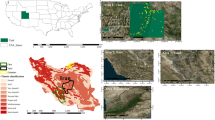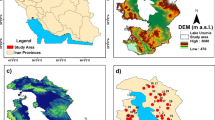Abstract
Many hydrologic phenomena and applications such as drought, flood, irrigation management and scheduling needs high resolution satellite soil moisture data at a local/regional scale. Downscaling is a very important process to convert a coarse domain satellite data to a finer spatial resolution. Three artificial intelligence techniques along with the generalized linear model (GLM) are used to improve the spatial resolution of Soil Moisture and Ocean Salinity (SMOS) derived soil moisture, which is currently available at a very coarse scale of ~40 Km. Artificial neural network (ANN), support vector machine, relevance vector machine and generalized linear models are chosen for this study to integrate the Moderate Resolution Imaging Spectroradiometer (MODIS) Land Surface Temperature (LST) with the SMOS derived soil moisture. Soil moisture deficit (SMD) derived from a hydrological model called PDM (Probability Distribution Model) is used for the downscaling performance evaluation. The statistical evaluation has also been made with the day-time and night-time MODIS LST differences with the mean day and night-time PDM SMD data for the selection of effective MODIS products. The accuracy and robustness of all the downscaling algorithms are discussed in terms of their assumptions and applicability. The statistical performance indices such as R 2, %Bias and RMSE indicates that the ANN (R 2 = 0.751, %Bias = −0.628 and RMSE = 0.011), RVM (R 2 = 0.691, %Bias = 1.009 and RMSE = 0.013), SVM (R 2 = 0.698, %Bias = 2.370 and RMSE = 0.013) and GLM (R 2 = 0.698, %Bias = 1.009 and RMSE = 0.013) algorithms on the whole are relatively more skillful to downscale the variability of the soil moisture in comparison to the non-downscaled data (R 2 = 0.418 and RMSE = 0.017) with the outperformance of ANN algorithm. The other attempts related to growing and non-growing seasons have been used in this study to reveal that season based downscaling is even better than continuous time series with fairly high performance statistics.







Similar content being viewed by others
References
Al-Shrafany D, Rico-Ramirez M, Han D (2012a) Calibration of roughness parameters using rainfall runoff water balance for satellite soil moisture retrieval. J Hydrol Eng 17:704–714. doi:10.1061/(ASCE)HE.1943-5584.0000508
Al-Shrafany D, Rico-Ramirez M, Han D, Bray M (2012b) Comparative assessment of soil moisture estimation from land surface model and satellite remote sensing based on catchment water balance. Met Apps. doi:10.1002/met.1357
Anderson JA, Davis J (1995) An introduction to neural networks, vol 1. MIT Press, Cambridge, MA
Bishop CM, Tipping ME (2000) Variational relevance vector machines. Proceedings of the Sixteenth conference on Uncertainty in artificial intelligence. Morgan Kaufmann Publishers Inc
Caputo B, Sim K, Furesjo F, Smola A (2002) Appearance-based Object Recognition using SVMs: which Kernel Should I Use?. In Proc of NIPS workshop on Statistical methods for computational experiments in visual processing and computer vision, Whistler (Vol. 2002)
Carlson T (2007) An overview of the“ triangle method” for estimating surface evapotranspiration and soil moisture from satellite imagery. Sensors 7(8):1612–1629
Foody G (2008) RVM–based multi–class classification of remotely sensed data. Int J Remote Sens 29(6):1817–1823
Gao J (2008) Digital analysis of remotely sensed imagery. McGraw-Hill Professional
Ghosh S, Mujumdar P (2008) Statistical downscaling of GCM simulations to streamflow using relevance vector machine. Adv Water Resour 31(1):132–146
Goward SN, Xue Y, Czajkowski KP (2002) Evaluating land surface moisture conditions from the remotely sensed temperature/vegetation index measurements: an exploration with the simplified simple biosphere model. Remote Sens Environ 79(2):225–242
Han D, Cluckie I (2004) Support vector machines identification for runoff modeling. In: pp 21–24
Han D, Yang Z (2001) River flow modelling using support vector machines. In: pp 494–499
Han D, Kwong T, Li S (2007) Uncertainties in real–time flood forecasting with neural networks. Hydrol Process 21(2):223–228
Ishak A, Remesan R, Srivastava P, Islam T, Han D (2013) Error correction modelling of wind speed through hydro-meteorological parameters and mesoscale model: a hybrid approach. Water Resour Manag 27(1):1–23. doi:10.1007/s11269-012-0130-1
Islam T, Rico-Ramirez MA, Han D, Srivastava PK (2012) Artificial intelligence techniques for clutter identification with polarimetric radar signatures. Atmos Res 109–110:95–113. doi:10.1016/j.atmosres.2012.02.007
Jackson TJ (1993) III. Measuring surface soil moisture using passive microwave remote sensing. Hydrol Process 7(2):139–152
Johnson RA, Wichern DW (2002) Applied multivariate statistical analysis, vol 4. Prentice Hall, Upper Saddle River
Karatzoglou A, Smola A, Hornik K, Zeileis A (2005) Kernlab–kernel methods. R package, Version 0.6-2. http://epub.wu.ac.at/1048/
Kerr YH, Waldteufel P, Wigneron JP, Martinuzzi J, Font J, Berger M (2001) Soil moisture retrieval from space: the Soil Moisture and Ocean Salinity (SMOS) mission. IEEE Trans Geosci Rem Sens 39(8):1729–1735
Kerr Y, Waldteufel P, Richaume P, Davenport I, Ferrazzoli P, Wigneron J (2006) SMOS level 2 processor soil moisture algorithm theoretical basis document (ATBD). SM-ESL (CBSA), CESBIO, Toulouse, SO-TN-ESL-SM-GS-0001, V5 a, 15/03
Kerr YH, Waldteufel P, Richaume P, Wigneron JP, Ferrazzoli P, Mahmoodi A, Al Bitar A, Cabot F, Gruhier C, Juglea SE (2012) The SMOS soil moisture retrieval algorithm. IEEE Trans Geosci Rem Sens 50(5):1384–1403
Legates DR, Mahmood R, Levia DF, DeLiberty TL, Quiring SM, Houser C, Nelson FE (2011) Soil moisture: a central and unifying theme in physical geography. Prog Phys Geogr 35(1):65–86
Lindsey JK (1997) Applying generalized linear models. Springer Verlag, New York
Liu J, Han D (2010) Indices for calibration data selection of the rainfall-runoff model. Water Resour Res 46(4):W04512
Mallick K, Bhattacharya BK, Patel N (2009) Estimating volumetric surface moisture content for cropped soils using a soil wetness index based on surface temperature and NDVI. Agric For Meteorol 149(8):1327–1342
McCullagh P, Nelder JA (1989) Generalized linear models. Chapman & Hall/CRC
Merlin O, Walker JP, Chehbouni A, Kerr Y (2008) Towards deterministic downscaling of SMOS soil moisture using MODIS derived soil evaporative efficiency. Remote Sens Environ 112(10):3935–3946
Mladenova I, Lakshmi V, Jackson TJ, Walker JP, Merlin O, de Jeu RAM (2011) Validation of AMSR-E soil moisture using L-band airborne radiometer data from National Airborne Field Experiment 2006. Rem Sens Environ 115(8):2096–2103
Moody J, Hanson S, Krogh A, Hertz JA (1995) A simple weight decay can improve generalization. Adv Neural Inform Process Syst 4:950–957
Moore R (2007) The PDM rainfall-runoff model. Hydrol Earth Syst Sci 11(1):483–499
Panciera R, Walker JP, Kalma JD, Kim EJ, Hacker JM, Merlin O, Berger M, Skou N (2008) The NAFE’05/CoSMOS data set: toward SMOS soil moisture retrieval, downscaling, and assimilation. IEEE Trans Geosci Rem Sens 46(3):736–745
Piles M, Camps A, Vall-Llossera M, Corbella I, Panciera R, Rudiger C, Kerr YH, Walker J (2011) Downscaling SMOS-derived soil moisture using MODIS visible/infrared data. IEEE Trans Geosci Rem Sens 49(9):3156–3166
Pinori S, Crapolicchio R, Mecklenburg S (2008) Preparing the ESA-SMOS (Soil Moisture and Ocean Salinity) mission-Overview of the user data products and data distribution strategy. Microwave Radiometry and Remote Sensing of the Environment, 2008. MICRORAD 2008. IEEE
RDevelopment C (2010) TEAM. 2006. R: a language and environment for statistical computing. R Foundation for Statistical Computing, Vienna, Austria. ISBN 3-900051-07-0, URL http://www.R-project.org
Remesan R, Shamim MA, Han D, Mathew J (2009) Runoff prediction using an integrated hybrid modelling scheme. J Hydrol 372(1–4):48–60
Ridler ME, Sandholt I, Butts M, Lerer S, Mougin E, Timouk F, Kergoat L, Madsen H (2012) Calibrating a soil–vegetation–atmosphere transfer model with remote sensing estimates of surface temperature and soil surface moisture in a semi arid environment. J Hydrol 436–437:1–12
Ripley B (2009) Feed-forward neural networks and multinomial log-linear models. R-package
Sandholt I, Rasmussen K, Andersen J (2002) A simple interpretation of the surface temperature/vegetation index space for assessment of surface moisture status. Remote Sens Environ 79(2):213–224
Schoof JT, Pryor S (2001) Downscaling temperature and precipitation: a comparison of regression–based methods and artificial neural networks. Int J Climatol 21(7):773–790
Sivapragasam C, Muttil N (2005) Discharge rating curve extension–a new approach. Water Resour Manag 19(5):505–520
Srivastava PK, Han D, Rico-Ramirez MA (2012a) Assessment of SMOS satellite derived soil moisture for soil moisture deficit stimation. Symposium on Prediction in Ungauged basin (PUBS) co-organized by Delft University of Technology, Delft, Netherlands and International Association of Hydrological Sciences (IAHS) dated 22–25 October 2012:1
Srivastava PK, Han D, Rico-Ramirez MA, Bray M, Islam T (2012b) Selection of classification techniques for land use/land cover change investigation. Adv Space Res 50(9):1250–1265. doi:10.1016/j.asr.2012.06.032
Srivastava PK, Han D, Rico-Ramirez MA (2013a) Data fusion techniques for an improved soil moisture retrieval using SMOS and WRF-NOAH Land surface model SMOS land application workshop, ESA-ESRIN, Frascati, Italy 25–27 February 2013
Srivastava PK, Han D, Rico-Ramirez MA, Islam T (2013b) Comparative assessment of evapotranspiration derived from NCEP and ECMWF global datasets through Weather Research and Forecasting model. Atmos Sci Lett. doi:10.1002/asl.427
Thakur J, Srivastava PK, Singh SK, Vekerdy Z (2012) Ecological monitoring of wetlands in semi-arid region of Konya closed Basin, Turkey. Reg Environ Chang 12(1):133–144. doi:10.1007/s10113-011-0241-x
Tipping ME (2001) Sparse Bayesian learning and the relevance vector machine. J Mach Learn Res 1:211–244
Trigo RM, Palutikof JP (2001) Precipitation scenarios over Iberia: a comparison between direct GCM output and different downscaling techniques. J Clim 14(23):4422–4446
Vapnik V, Golowich SE, Smola A (1997) Support vector method for function approximation, regression estimation, and signal processing. Adv Neural Inform Process Syst 9:281–287
Wagner W, Naeimi V, Scipal K, de Jeu R, Martínez-Fernández J (2007) Soil moisture from operational meteorological satellites. Hydrogeol J 15(1):121–131
Wan Z (1999) MODIS land-surface temperature algorithm theoretical basis document (LST ATBD). Institute for Computational Earth System Science, Santa Barbara, 75
Wang YM, Traore S, Kerh T, Leu JM (2011) Modelling reference evapotranspiration using feed forward backpropagation algorithm in arid regions of Africa. Irrig Drain 60(3):404–417
Weichert A, Bürger G (1998) Linear versus nonlinear techniques in downscaling. Clim Res 10:83–93
Wu C, Chau K (2011) Rainfall-runoff modeling using artificial neural network coupled with singular spectrum analysis. J Hydrol 399(3):394–409
Zhang Y, Ding X, Liu Y, Griffin P (1996) An artificial neural network approach to transformer fault diagnosis. IEEE Trans Power Deliv 11(4):1836–1841
Zhang G, Patuwo BE, Hu MY (1998) Forecasting with artificial neural networks: the state of the art. Int J Forecast 14(1):35–62
Acknowledgments
The authors would like to thank the Commonwealth Scholarship Commission, British Council, United Kingdom and Ministry of Human Resource Development, Government of India for providing the necessary support and funding for this research. The authors are highly thankful to the European Space Agency for providing the SMOS data. The authors would like to acknowledge the British Atmospheric Data Centre, United Kingdom for providing the ground observation datasets. The authors also acknowledge the Advanced Computing Research Centre at University of Bristol for providing the access to supercomputer facility (The Blue Crystal).
Author information
Authors and Affiliations
Corresponding author
Rights and permissions
About this article
Cite this article
Srivastava, P.K., Han, D., Ramirez, M.R. et al. Machine Learning Techniques for Downscaling SMOS Satellite Soil Moisture Using MODIS Land Surface Temperature for Hydrological Application. Water Resour Manage 27, 3127–3144 (2013). https://doi.org/10.1007/s11269-013-0337-9
Received:
Accepted:
Published:
Issue Date:
DOI: https://doi.org/10.1007/s11269-013-0337-9




